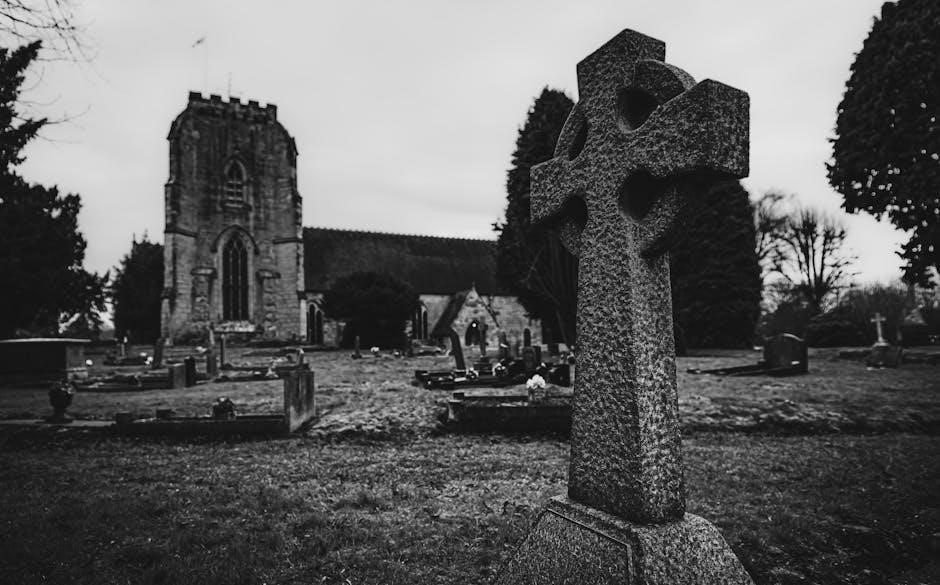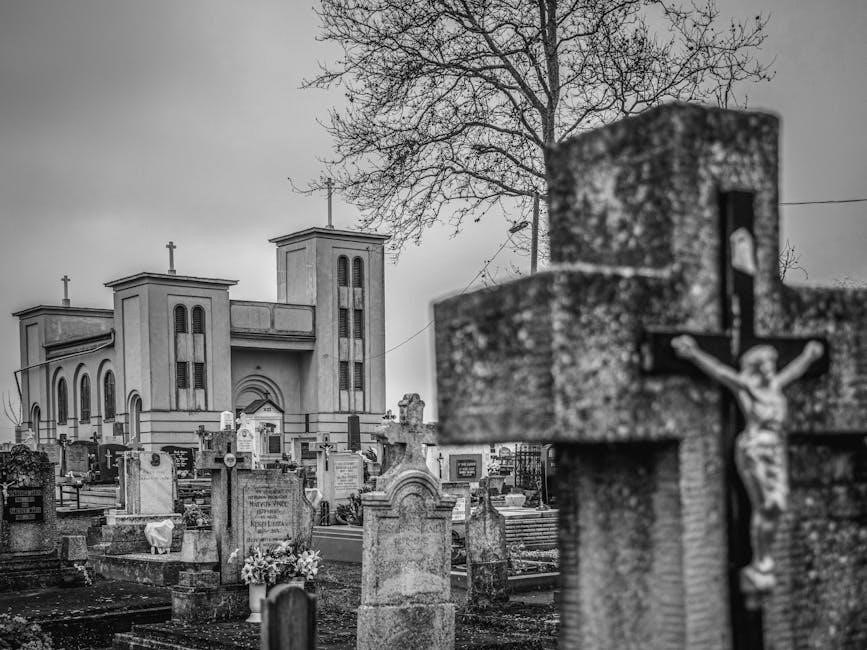A funeral resolution is a formal statement honoring the deceased, expressing condolences, and celebrating their life. It is often used in African American church traditions to provide comfort and acknowledge the individual’s contributions.
1.1 Definition and Purpose of Funeral Resolutions
A funeral resolution is a formal, written statement that honors the life and legacy of the deceased. It serves as a heartfelt tribute, acknowledging the individual’s contributions, achievements, and impact on their family, community, and church. The purpose of a funeral resolution is to celebrate the deceased’s life, provide comfort to the grieving, and create a lasting remembrance. In African American church traditions, these resolutions are often presented during the funeral service or memorial, emphasizing the deceased’s spiritual journey and faith. They are typically formal, yet personal, and may include biblical references or hymns to reflect the individual’s religious devotion. Funeral resolutions are also shared with the congregation, serving as a unifying moment of reflection and collective mourning. Their structured format ensures dignity and respect, making them a meaningful part of the funeral proceedings.
1.2 Significance in African American Church Traditions

In African American church traditions, funeral resolutions hold profound cultural and spiritual significance. They are a vital part of the funeral service, serving as a way to honor the deceased and celebrate their life’s journey. These resolutions are often infused with religious and cultural elements, reflecting the community’s deep-rooted faith and heritage. They provide a platform to acknowledge the individual’s contributions to the church and society, reinforcing their legacy. The resolution is typically read aloud during the service, offering comfort to the family and congregation. It also serves as a unifying moment, strengthening communal bonds and shared grief. The structured and formal nature of these resolutions ensures they are presented with the utmost respect and dignity, aligning with the traditions of the African American church. This practice underscores the importance of community, faith, and remembrance in honoring the deceased.
Structure of a Funeral Resolution
A funeral resolution typically includes a preamble, body, and closing. The preamble introduces the purpose, the body details the deceased’s life and contributions, and the closing offers condolences and final remarks.
2.1 Preamble: Opening Statement
The preamble of a funeral resolution serves as the opening statement, setting the tone for the entire document. It typically begins with a formal acknowledgment of the deceased and the purpose of the resolution. This section often includes the deceased’s name, the date of passing, and a statement expressing collective sympathy. The preamble is concise yet meaningful, providing a foundation for the details that follow. It is usually written in a respectful and dignified tone, reflecting the solemnity of the occasion. In African American church traditions, the preamble may also include a reference to the church’s name and the date of the service. The goal is to honor the deceased while offering comfort to the grieving family and community. This opening statement is crucial as it sets the stage for celebrating the life and legacy of the individual being remembered.

2.2 Body: Details of the Deceased’s Life and Contributions
The body of a funeral resolution is dedicated to honoring the deceased by detailing their life, achievements, and contributions. This section serves as a tribute, highlighting the individual’s personal and professional accomplishments, as well as their role within the church and community. It often includes specific examples of their dedication, such as leadership roles, volunteer work, or acts of kindness. The body also reflects on the deceased’s personality, values, and how they impacted others. In African American church traditions, this part of the resolution may emphasize the individual’s faith journey and their commitment to the church. The goal is to create a heartfelt and meaningful portrait of the deceased, ensuring their legacy is remembered and celebrated. This section is crafted with care to provide comfort to the grieving family and friends while honoring the life lived.
2.3 Closing: Condolences and Final Remarks
The closing section of a funeral resolution offers heartfelt condolences to the grieving family and loved ones. It serves as a final tribute, expressing sympathy and support during their time of sorrow. This part often includes a prayer or blessing, seeking comfort and strength from a higher power. The closing remarks may also encourage the family to find solace in cherished memories and the legacy left by the deceased. In African American church traditions, this section may incorporate scripture or spiritual reflections to provide hope and reassurance. The tone is compassionate and uplifting, emphasizing the deceased’s eternal rest and the community’s collective grief. The closing is a poignant conclusion, reaffirming the church’s support and solidarity with the bereaved. It is a final farewell that honors the deceased while offering comfort to those who mourn.
Creating a Black Printable Church Funeral Resolution
Creating a black printable church funeral resolution involves compiling the deceased’s life details, crafting a respectful tribute, and designing a printable template that honors their legacy with dignity and clarity.
3.1 Gathering Information About the Deceased
Gathering accurate and meaningful information about the deceased is the first step in creating a black printable church funeral resolution. This includes biographical details such as their full name, birth and death dates, and place of residence. Additionally, it’s important to collect information about their involvement in the church, including leadership roles, ministries they participated in, and any significant contributions they made. Personal qualities, such as their character, hobbies, and how they impacted others, should also be noted. Family members, close friends, and church leaders can provide valuable insights and anecdotes to ensure the resolution is comprehensive and heartfelt. Organizing this information in a structured manner will help in crafting a resolution that honors the deceased’s legacy and provides comfort to mourners. Attention to detail ensures the resolution reflects the individual’s life accurately and respectfully.
3.2 Writing the Resolution: Tips and Guidelines

Writing a funeral resolution requires a thoughtful and compassionate approach. Begin by establishing a respectful and dignified tone, reflecting the deceased’s character and contributions. Start with a preamble that introduces the purpose of the resolution, followed by the body, which details the individual’s life, achievements, and impact on the church and community. Use formal language, avoiding slang or informal expressions, to maintain the solemnity of the occasion. Ensure accuracy by cross-referencing the information gathered about the deceased. Personalize the resolution by incorporating anecdotes, quotes, or scriptures that resonate with their life and faith. Avoid overly lengthy sentences and keep the content concise yet meaningful. Finally, conclude with heartfelt condolences to the family and a reaffirmation of shared grief and celebration of life; Review the resolution for clarity and grammar before finalizing it. Seeking feedback from family members or church leaders can also enhance its authenticity and appropriateness.
3.3 Design Elements for a Printable Template
A well-designed printable funeral resolution template ensures a professional and respectful presentation. Begin with a somber color scheme, such as black, navy, or dark gray, to convey mourning. Use a clean, organized layout with clear sections for the preamble, body, and closing. Incorporate a traditional serif font, like Times New Roman, for a formal appearance, and ensure proper spacing between paragraphs for readability. Add a subtle border or frame to give the document a polished look. Religious symbols, such as a cross or dove, can be included to align with the cultural and spiritual context. Placeholders for the deceased’s name, dates of birth and death, and space for personalized content are essential. Ensure the template is compatible with standard paper sizes and printers for ease of use. Avoid overly decorative elements that may distract from the solemnity of the occasion. The design should reflect dignity, respect, and cultural sensitivity, making it suitable for African American church traditions.
3.4 Sample Funeral Resolution Template
A sample funeral resolution template provides a structured format to honor the deceased. It typically begins with a title, such as “In Loving Memory of [Name],” followed by a preamble expressing condolences. The body includes details about the individual’s life, achievements, and contributions to the church and community. A section for closing remarks offers final words of comfort and farewell. The template should be customizable, allowing for personalization with photos, scriptures, or hymns. Ensure the language is respectful and aligns with cultural traditions, particularly for African American church services. The template should be easy to edit and print, with clear sections for dates, names, and specific memories. Including placeholders for the funeral date, location, and officiating minister adds practicality. The design should maintain a professional and solemn appearance, making it suitable for distribution during the service or as a keepsake for mourners.

Downloading and Printing the Funeral Resolution
Downloading a funeral resolution template is straightforward. Visit trusted sources like church websites or template platforms. Print on high-quality paper, ensuring clarity and readability. Choose appropriate fonts and colors to maintain a respectful appearance.
4.1 Sources for Printable Funeral Resolution Templates
Several reliable sources offer printable funeral resolution templates tailored for African American church traditions. Church websites, funeral homes, and online template platforms provide customizable options. Many templates are designed to honor the deceased with dignity and respect. They often include sections for personalization, ensuring the resolution reflects the individual’s life and contributions. Some popular sources include church-specific resources, community organizations, and platforms specializing in funeral materials. These templates are typically free or low-cost, making them accessible to everyone. They are designed to save time while maintaining a professional and heartfelt presentation. Additionally, many templates are formatted in PDF, ensuring high-quality printing. When selecting a template, consider the specific needs of the service and the preferences of the family. These resources help create a meaningful and lasting tribute to the deceased.
4.2 Printing Tips for High-Quality Output
To ensure a professional and respectful presentation, use high-quality paper with a resolution of 24-28 lb for printing funeral resolutions. Choose a clean, readable font like Times New Roman in size 12 points. Ensure proper margins and alignment to avoid cut-off text. Print in black ink for clarity, and use a laser printer for crisp text. For color sections, maintain consistency across all pages. Test print a sample to check formatting and ink levels. Bind the resolution with a staple or folder for a polished look. Avoid low-quality paper to prevent smudging or fading. Double-check the PDF for proper layout before printing. Consider using cardstock for a more durable finish. Ensure the printer is set to “actual size” to maintain the template’s design. Finally, have a second person review the printed document for any errors or omissions.

Best Practices for Funeral Resolutions
Ensure the resolution is personalized, respectful, and dignified. Involve the church community for collective input. Use clear and heartfelt language to honor the deceased and provide comfort to mourners.
5.1 Personalizing the Resolution
Personalizing a funeral resolution ensures it reflects the deceased’s unique life and contributions. Include specific anecdotes, achievements, and qualities that defined them. Highlight their role in the church and community, as well as their faith journey. Use personal photos or meaningful symbols in the design to make it more intimate. Involve family and close friends in the drafting process to gather heartfelt memories and ensure accuracy. Tailor the language to resonate with the deceased’s personality, whether formal or warm. Avoid generic phrases that do not capture their essence. Reflect on their legacy and how they impacted others, emphasizing their influence on the church and its members. Ensure the resolution aligns with the church’s values and traditions while remaining deeply personal. A well-crafted, personalized resolution honors the deceased and provides comfort to those grieving, celebrating their life with authenticity and love.
5.2 Ensuring Respectful and Dignified Language
Using respectful and dignified language is crucial when crafting a funeral resolution. Avoid slang, informal expressions, or overly casual phrases that may detract from the solemnity of the occasion. Instead, opt for formal, reverent language that honors the deceased and provides comfort to mourners. Address the deceased with appropriate titles, such as “Brother,” “Sister,” or “Deacon,” reflecting their role in the church. Focus on their positive attributes, contributions, and faith journey, emphasizing their impact on the community. Avoid negative or controversial remarks, ensuring the resolution remains a celebration of life. Use biblical references or hymns to align with church traditions and provide spiritual solace. Balance personalization with decorum, ensuring the tone remains compassionate and uplifting. Proofread the resolution to eliminate errors and ensure clarity. By maintaining a respectful and dignified tone, the resolution will serve as a fitting tribute to the deceased and a source of strength for those grieving.

5.3 Involving the Church Community
Involving the church community in creating a funeral resolution ensures a collective expression of grief and celebration of the deceased’s life. Encourage members to share memories, anecdotes, and testimonials about the individual’s contributions to the church and community. This collaborative approach fosters unity and provides a sense of ownership among congregants. Assign a committee or designate a leader to gather input, ensuring diverse perspectives are represented. Consider holding a meeting or using digital tools to collect thoughts and stories. Incorporate feedback respectfully, maintaining the resolution’s dignity and focus. By involving the community, the resolution becomes a heartfelt, communal tribute that honors the deceased and offers comfort to all. This process also strengthens bonds within the church, demonstrating the power of shared faith and support during difficult times.

Cultural Considerations

Cultural considerations in funeral resolutions involve honoring traditional rituals, music, and attire. They reflect the community’s heritage and values, ensuring the deceased’s legacy is celebrated with authenticity and respect.
6.1 African American Funeral Traditions
African American funeral traditions are deeply rooted in cultural and religious practices, emphasizing community, dignity, and celebration of life. Music, such as hymns and spirituals, plays a central role, offering comfort and connection to heritage. Eulogies are often heartfelt, honoring the deceased’s contributions and legacy. The funeral resolution, a formal statement, is read to acknowledge the individual’s impact and provide solace to the family. These traditions also include the repast, a gathering where loved ones share food and memories, strengthening communal bonds. The church serves as a sanctuary for mourning and healing, blending sorrow with resilience. These customs reflect the richness of African American culture, ensuring the deceased is remembered with respect and their spirit celebrated. By adhering to these traditions, the community upholds its heritage while supporting the grieving family.

6.2 Incorporating Religious and Cultural Elements
Incorporating religious and cultural elements into a funeral resolution is essential for honoring the deceased and providing comfort to the grieving family. African American church traditions often emphasize the inclusion of scripture, hymns, and prayers, which serve as a source of strength and solace. Cultural elements, such as traditional attire, music, or rituals, can also be seamlessly integrated to reflect the deceased’s heritage. These elements not only celebrate the individual’s life but also create a sense of community and shared experience. By blending religious and cultural practices, the funeral resolution becomes a meaningful tribute that resonates deeply with those in attendance. This approach ensures that the deceased is remembered with dignity and their legacy is celebrated in a way that aligns with their beliefs and traditions.
A funeral resolution is a meaningful way to honor the life and legacy of the deceased while providing comfort to the grieving family and community. By incorporating personal details, cultural traditions, and religious elements, a well-crafted resolution ensures a dignified and heartfelt tribute. The use of printable templates, such as a black printable church funeral resolution PDF, simplifies the process of creating and sharing this important document. It allows for professional presentation and ease of distribution during the service. Ultimately, a funeral resolution serves as a lasting remembrance of the deceased, celebrating their contributions and offering solace to those who mourn. Its significance in African American church traditions underscores its role in fostering unity and healing during times of loss;
